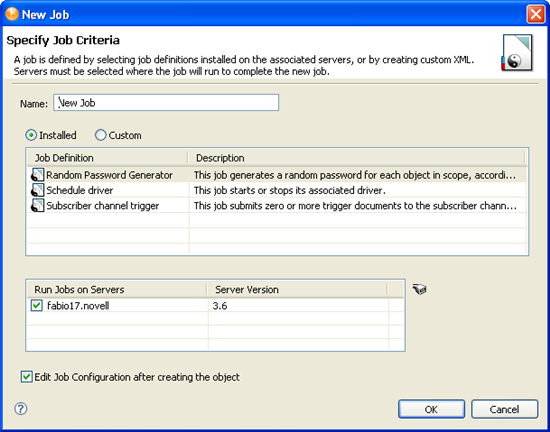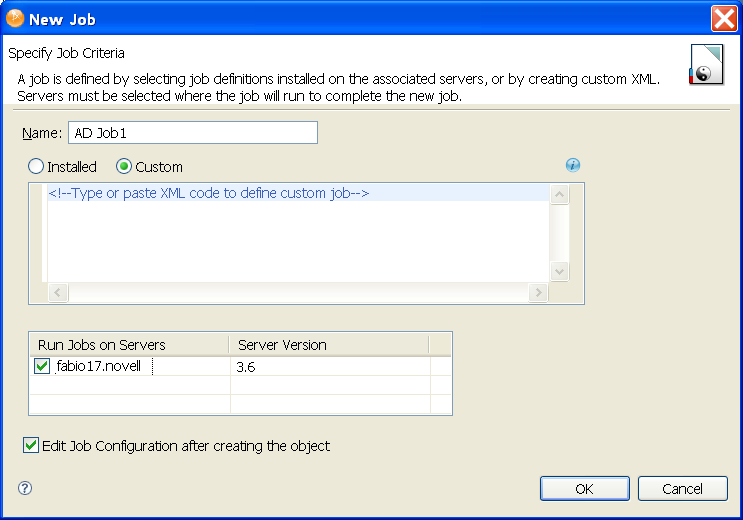14.1 Creating a Job
-
In the Outline view, right-click a driver and select .
NOTE:You can also right-click a driver set and select to create a driver health job. For more information about driver health configuration and the driver health job, see Section 4.7.10, Driver Health Configuration.
This opens the New Job page.
-
In the field, specify a descriptive name for the job, or use the default name provided.

-
Select to create a job using an existing job definition, or select to create a custom job definition for this job.
-
If you are creating a job from an existing job definition, select the job definition you want to use from the list of available jobs.
Choose a definition for the job. The New Job Wizard comes with three job definitions.
-
Random Password Generator: Generates a random password for each object in the job’s scope. The password is generated by NMAS to match the Password Policy object that the job references. These Password Policy objects are not usually the same as those used for eDirectory user password policies.
The job submits the generated passwords one at a time to the driver’s Subscriber channel. The Subscriber channel policies must do something useful with the passwords.
-
Schedule Driver: Starts or stops the associated driver. You can also toggle a driver to start the driver if it is stopped or to stop the driver if it is running.
-
Subscriber Channel Trigger: Submits zero or more trigger documents to the Subscriber channel. The submission can either be a document per object if a scope is defined, or it can be a single trigger event if no scope is defined.
Trigger event documents identify the job and the scope object. A trigger event can bypass the cache and “go to the head of the queue” if desired. You will probably use trigger jobs the most; they allow you to use driver policies that you can customize for your personal requirements.
NOTE:Click the icon
 to display any custom job definitions on the selected server. Since Designer is an offline modeling tool, only the Identity Manager job definitions display by default.
to display any custom job definitions on the selected server. Since Designer is an offline modeling tool, only the Identity Manager job definitions display by default.
-
-
If you are creating a custom job definition, paste the job definition XML into the code field.

The code field isn’t designed for entering XML directly, although you can do so if desired. Identity Manager provides a Job Scheduler DTD that defines the XML structure for job definitions. For more information, see Jobs DTD in the Novell Identity Manager DTD Reference.
NOTE:The Job Scheduler automatically validates the custom job XML against the DTD specified in the content, or against the default Job Scheduler DTD if none is specified. It marks any errors it finds so you can review them, and requires you to fix serious errors before allowing you to save the custom job.
-
-
In the field, select the servers where you want to run the job.
-
Select if you want Designer to open the newly created job in the IDM Job Editor window after saving the job object.
-
Click .
The File Conflict window informs you that you must save the job object to continue. Click to save the job and continue.
Continue with Job Editor Selections on the General Settings Page.
14.1.1 Copying a Job
There are two ways to create a new job based on an existing job:
-
In the Outline view, right-click an existing job object, then select . This creates a duplicate job object in the same location as the original job object.
-
Right-click a driver, then select > . This is useful if you want to create a job in a different location from the original job object. For example, in a different driver.
In either case, once you create the new job object, you can then edit the job as needed to fit your needs. For more information, see Section 14.2, Editing a Job.